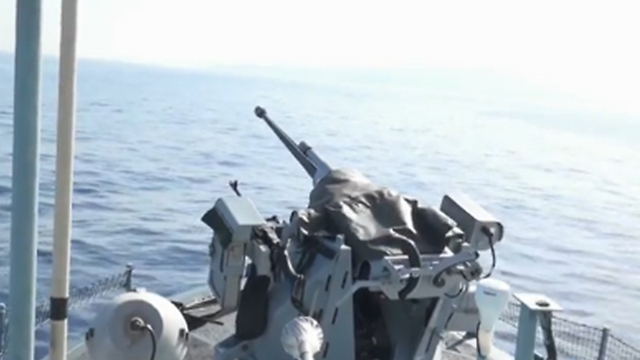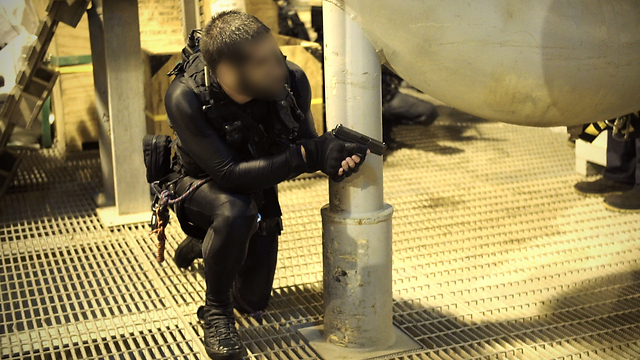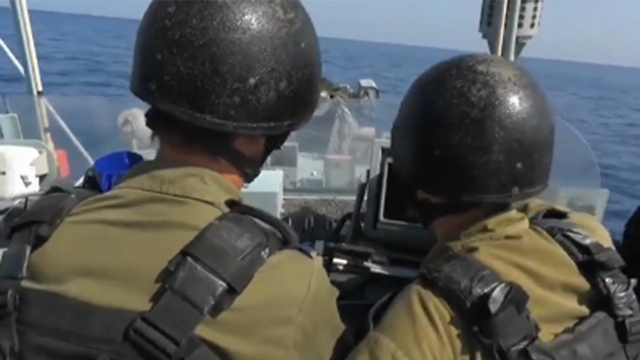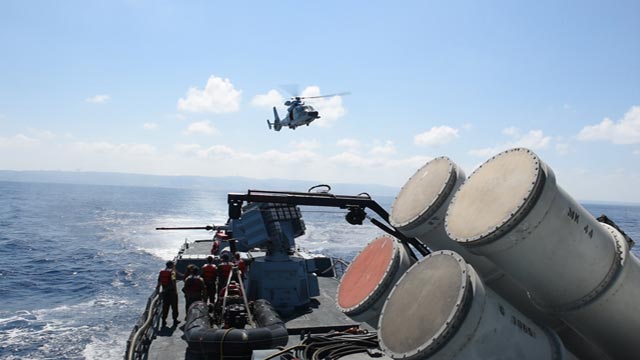
 In a recent off-shore exercise, Israel’s elite naval forces drilled its troops’ response to a developing & very real underwater incursion threat posed by Hamas & Hezbollah.
In a recent off-shore exercise, Israel’s elite naval forces drilled its troops’ response to a developing & very real underwater incursion threat posed by Hamas & Hezbollah.
By Yoav Zitun
The Israeli Navy on Wednesday revealed a series of exercises and experiments conducted this year aimed at improving reactions to nascent threats. The exercises included one simulating incursion and another simulating rocket fire at oil rigs off Israel’s coast.
The scenario in which seaborne terrorists make an incursion into Israel’s northernmost coastal region, between Rosh Hanikra and Nahariya, is grounded in reality; a similar attempt took place during last summer’s Operation Protective Edge, in which Hamas frogmen disembarked on a southern shore.

Photo: IDF Spokesperson
The Navy has raised its alert levels, and drafted operational doctrines to meet the challenge of above- and below-surface warfare carried out by terrorist groups, who continue to expand their capabilities, and pose a real threat.
The latest exercise featured a seemingly innocuous Lebanese fishing vessel suspiciously approaching towards Israel’s territorial waters adjacent to Rosh Hanikra. The Navy ships on patrol were then called into the area.
Soldiers from the Navy’s Snapir unit acted out the role of the Hezbollah terrorists, in order to manifest the threat posed by these incursions to the soldiers participating in the exercise. The soldiers on board the Dabur ship acted out their response, “firing” towards the ship after it failed to heed their warnings to stop its approach towards beachgoers. At the same time, forces from the Nahal infantry battalion currently stationed in the region were dispatched to the area, as well as troops from elite units who specialize in this type of warfare.

IDF commando during exercise – Photo: IDF Spokesperson
The Navy decided to drill the theoretical threat to the extreme. In the exercise, the terrorists managed to get near the shore in boats without being stopped, and began swimming towards the busy beach. The beach was immediately evacuated, and the terrorists where “shot” by the forces waiting for them onshore.
“Our goal is to stop the threat out at sea, to identify the threat as a suspicious vessel in Lebanese waters,” an officer from the Navy’s command and control center in Rosh Hanikra told ynet. “Almost everyday our marine control observers identify these Lebanese fishing boats near the maritime border, and we are always prepared to repel them if they come close. An event like this could occur at any moment, and not only during periods of conflict, and that’s why we are always on guard. A boat with an engine coming from Lebanon can be inside of Israel’s territorial waters within a matter of minutes, and unload armed swimmers or divers towards the beach.”

Photo: IDF Spokesperson
According to the officer from the Navy’s 914 active security company, “An incursion by boat can take 2-5 minutes, and when combined with the time it takes to swim the rest, we are talking about 7-10 minutes for an attack of this type. The border is always tense and there is a constant sense of operational readiness, and our job is to maintain this readiness year round.”
The Navy is also preparing for the threat posed by Hezbollah divers, who can try and come ashore on public beaches or onto Rosh Hanikra’s rocky shore from the Lebanese beaches, located a mere couple of hundred meters away. In recent months, the Navy has deployed dozens of sensors from a new system named “Aqua Shield” on the seafloor near Gaza and Lebanon’s water borders with Israel. The new system can detect and alert the Navy to suspicious underwater movements.

Photo: IDF Spokesperson
If the system detects movement, active security vessels are dispatched to the scene with special explosive devices containing thousands of pieces of shrapnel, in an effort to eliminate the terrorists while they are still in the water. The company’s commander Lt. Col. Ronen Mirkam said, “We can see Hezbollah stockpiling and developing capabilities, and we are prepping up against these enemy capabilities, and not just according to the enemies’ intentions.”
“We must assume that every capability available today will be used against us, and we have prepared for all of them, even when they are not in the framework of a war.”

Photo: IDF Spokesperson
A second exercise simulated interception of an anti-ship missile of the likes possessed by Syria and Hezbollah, using a Barak 8 surface-to-air missile installed on the navy’s missile boats.
The current assumption in the IDF is that Hezbollah can hit oil rigs, which supply about 60 percent of the electricity consumed in Israel. The IDF believes this will occur, even though the missiles have not reached the Shi’ite organization’s hands – but Assad’s army possesses dozens.
The anti-ship missiles could strike oil rigs as an easy target, but they can hit anywhere within a 300-kilometer radius, meaning it could paralyze Israel’s two main ports in Ashdod and Haifa. “97 percent of imported goods arrive by sea, and stopping imports for weeks or months would damage the market’s continuing functionality,” the navy explained.
View original Ynet publication at:
http://www.ynetnews.com/articles/0,7340,L-4696788,00.html







 Israeli New Shekel Exchange Rate
Israeli New Shekel Exchange Rate